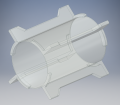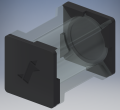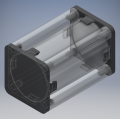Nex
Flush
This has been another side project I started around the same time as my cookie cutter project... and put it on the back burner for a good while after I was frustrated being unable to find any new ideas on how to design a connection for the tube caps to the tube itself which would not be so extremely brittle as the push-over clip design I was using back then. The clips would break off the cap after only one or two uses.
A couple of days ago, I remembered this project, and did another brainstorming session for connection design solutions. I believe I've come up with one now that is stable enough - it's a screw and clip combination. While I was working on the parts I also refined the tube, taking away a lot of unnecessary volume that would only waste filament and increase printing time.
The end caps have a pseudo "seal" that will plug about 1 mm into the tube to better keep lint out of the tube if you stow it away somewhere.
Impact / outside force resistance is questionable - I would avoid dropping them. But they will certainly keep chips nicely in order.

(Above photo is showing a beta version of the tube - it doesn't yet have the cutouts in the rails.)
Custom 33 chip capacity, for samples of all my custom CPCs.

Smooth or textured surface finish


Any color combination, any capacity (front left to right: 15, 8, 10 chips).
Also, Logo/Text embossing on caps.


Nicely fills that little leftover space in your transport case that won't really hold another regular chip rack.

Window cap close-up. The 3D printed "transparent" window could also be replaced by a piece of overhead transparency for example if you want clear sight.

Left to right on the print bed: One 20 chip tube; four 25 chip tubes with another 25 chip tube on top; two 50 chip tubes. The other ones off the print bed are all 25 chip capacity, including the ones without caps.
Foreground right: tube caps with windows.
Background right: Tons of demo tube cap sets in different colors.
Production stats:
39mm Tube (20 chips capacity): 2h 28m print time / 17.53 grams PETG
39mm Tube (25 chips capacity): 3h 00m print time / 21.17 grams PETG
39mm Tube (50 chips capacity): 5h 45m print time / 39.51 grams PETG
Dual end caps: 1h 31m print time / 19.08 grams PETG
Measurings were done using my Prusa i3 MK3S unit and PrusaSlicer 2.0.0.
Dimensions:
39mm tubes: 50mm L x 50mm W max (center section: 42mm x 42mm)
43mm tubes: 54mm L x 54mm W max (center section: 46mm x 46mm)
Capacity 20 chips (including end caps): 78mm H
Capacity 25 chips (including end caps): 95mm H
Capacity 50 chips (including end caps): 179mm H
This presents a lot of nice options...
Any chip diameter? Check. Any chip thickness? Check.
Also, any capacity, for example for tournament starting stacks. Perfect fit for 8/8/4/7? You can have that. What if I want a bounty chip in there too? Sure thing.
With the maximum print volume of my printer, I can produce tubes that hold up to 60 chips.
I've embossed my monogram on the end caps, which could also be swapped out for pretty much anything that doesn't have too thin lines. Or of course no logo at all. Or a shallow recess for a label. Or a see-through window. Sadly it's impossible to simply import some 2D vector graphic... you have to manually retrace the lines, else you end up with unusable geometry So logos are hard to do, unless it's all straight lines. But at least adding simple text is easy.
So logos are hard to do, unless it's all straight lines. But at least adding simple text is easy.
Models:



Bonus - old crappy clip design:

A couple of days ago, I remembered this project, and did another brainstorming session for connection design solutions. I believe I've come up with one now that is stable enough - it's a screw and clip combination. While I was working on the parts I also refined the tube, taking away a lot of unnecessary volume that would only waste filament and increase printing time.
The end caps have a pseudo "seal" that will plug about 1 mm into the tube to better keep lint out of the tube if you stow it away somewhere.
Impact / outside force resistance is questionable - I would avoid dropping them. But they will certainly keep chips nicely in order.
(Above photo is showing a beta version of the tube - it doesn't yet have the cutouts in the rails.)
Custom 33 chip capacity, for samples of all my custom CPCs.
Smooth or textured surface finish
Any color combination, any capacity (front left to right: 15, 8, 10 chips).
Also, Logo/Text embossing on caps.
Nicely fills that little leftover space in your transport case that won't really hold another regular chip rack.
Window cap close-up. The 3D printed "transparent" window could also be replaced by a piece of overhead transparency for example if you want clear sight.
Left to right on the print bed: One 20 chip tube; four 25 chip tubes with another 25 chip tube on top; two 50 chip tubes. The other ones off the print bed are all 25 chip capacity, including the ones without caps.
Foreground right: tube caps with windows.
Background right: Tons of demo tube cap sets in different colors.
Production stats:
39mm Tube (20 chips capacity): 2h 28m print time / 17.53 grams PETG
39mm Tube (25 chips capacity): 3h 00m print time / 21.17 grams PETG
39mm Tube (50 chips capacity): 5h 45m print time / 39.51 grams PETG
Dual end caps: 1h 31m print time / 19.08 grams PETG
Measurings were done using my Prusa i3 MK3S unit and PrusaSlicer 2.0.0.
Dimensions:
39mm tubes: 50mm L x 50mm W max (center section: 42mm x 42mm)
43mm tubes: 54mm L x 54mm W max (center section: 46mm x 46mm)
Capacity 20 chips (including end caps): 78mm H
Capacity 25 chips (including end caps): 95mm H
Capacity 50 chips (including end caps): 179mm H
This presents a lot of nice options...
Any chip diameter? Check. Any chip thickness? Check.
Also, any capacity, for example for tournament starting stacks. Perfect fit for 8/8/4/7? You can have that. What if I want a bounty chip in there too? Sure thing.
With the maximum print volume of my printer, I can produce tubes that hold up to 60 chips.
I've embossed my monogram on the end caps, which could also be swapped out for pretty much anything that doesn't have too thin lines. Or of course no logo at all. Or a shallow recess for a label. Or a see-through window. Sadly it's impossible to simply import some 2D vector graphic... you have to manually retrace the lines, else you end up with unusable geometry
Models:



Bonus - old crappy clip design:

Last edited:


